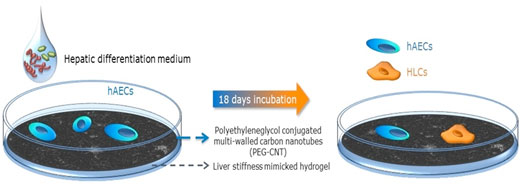| Posted: Sep 24, 2018 | |
Reconstructing healthy liver cells using a nanomaterial-based matrix(Nanowerk News) National University of Singapore (NUS) pharmaceutical scientists, together with clinicians from the National University Health System (NUHS), have developed a nanomaterial-based hydrogel that encourages amniotic epithelial cells (a type of stem cell) to grow into mature liver cells. |
|
| The liver performs many essential functions related to digestion, metabolism, immunity and storage of nutrients within the body. It is the body's "chemical factory", producing many important proteins and nutrients. It also breaks down toxic substances into harmless chemicals in the body. | |
| Not surprisingly, the majority of substances (including drugs) that enter the body are processed through the liver. This is why, a pathological condition in this organ is so deleterious and leaves very few therapeutic options. | |
| Liver diseases such as acute liver failure and liver cancer are increasingly prevalent health issues with no clear therapeutic solutions. Apart from a liver transplant, there are limited therapeutic options for the patient. However, there is a shortage of healthy livers from donors. | |
| Prof HO Han Kiat and Prof Giorgia PASTORIN, both from the Department of Pharmacy, NUS, have collaborated with Prof DAN Yock Young from NUHS to develop a hydrogel that can mimic the stiffness level and nanoscale surface roughness found in healthy human livers. | |
 |
|
| Figure shows amniotic stem cells taking on significant liver cell characteristics after growing on carbon nanotube surface. hAECs: Human amniotic epithelial cells. HLCs: Hepatocyte-like cells (cells which are similar to those found in liver tissue). (Image: NUS) | |
| When amniotic epithelial cells (AECs, a type of stem cell derived from the amniotic fluid in pregnant women) are grown onto this artificial matrix, they are stimulated to develop into mature liver cells. These liver cells can potentially be used in cell therapy and tissue engineering to help patients with liver conditions. | |
| These findings are built on an earlier discovery by Prof Ho and his collaborators. They had found that, when mesenchymal stem cells (another type of stem cell) are grown on a carbon nanotube-plated surface, they catalysed the transformation of stem cells into muscle cells even in the absence of additional growth factors (substances that stimulate growth in living cells). | |
| Using this strategy, the team adapted the original carbon nanotubes’ surface by incorporating them into a polyacrylamide gel. The idea is to recreate a softer matrix that better mimics that of a healthy liver to influence the transformation of the AECs into liver cells. | |
| Prof Ho said, “This effort yielded very encouraging results. We found that the AECs acquired significant liver cell characteristics with the corresponding loss of stem cell markers. These cells demonstrated liver-specific functions in terms of expressing albumin and drug metabolising capabilities. The goal now is to expand the characterisation of the liver function of these cells and to scale up production so that this can potentially be a sustainable resource for clinical applications.” | |
References |
|
| Zhao CY; Lin JS; Choolani M; Dan YY; Pastorin G; Ho HK, "Enhanced hepatic differentiation of human amniotic epithelial cells on polyethylene glycol-linked multiwalled carbon nanotube-coated hydrogels", Journal of Tissue Engineering and Regenerative Medicine Volume: 12 Issue: 7 Pages: 1556-1566 DOI: 10.1002/term.2672 Published: 2018. | |
| Zhao CY; Andersen H; Ozyilmaz B; Ramaprabhu S; Pastorin G; Ho HK, "Spontaneous and specific myogenic differentiation of human mesenchymal stem cells on polyethylene glycol-linked multi-walled carbon nanotube films for skeletal muscle engineering", Nanoscale Volume: 7 Issue: 43 Pages: 18239-18249 DOI: 10.1039/c5nr04303d Published: 2015. |
| Source: National University of Singapore | |
|
Subscribe to a free copy of one of our daily Nanowerk Newsletter Email Digests with a compilation of all of the day's news. |
